ACTION B2: PROOF OF ENVIRONMENTAL ADVANTAGES IN THE USE OF HYDROGEN TECHNOLOGIES AND FUEL CELLS WITHIN THE AQUACULTURE SECTOR.
ACTION B2: PROOF OF ENVIRONMENTAL ADVANTAGES IN THE USE OF HYDROGEN TECHNOLOGIES AND FUEL CELLS WITHIN THE AQUACULTURE SECTOR.
This action aims to proof the environmental benefits derived from the use of hydrogen technologies for aquaculture. ARIEMA will install an electrolysis prototype, system that generates hydrogen and oxygen, upon decomposition of the water molecule. The electrolyzer to be used is an alkaline equipment specifically designed to use not only hydrogen but also oxygen, and the prototype will count on a non-existent level of sensing and automation in commercial equipment. It will have specific auxiliary systems, such as the purification of oxygen and a system for the removal of potash, which reduces the risk of using oxygen.
Usually, the electrolysis process is performed for obtaining hydrogen, gas with high added value, being oxygen vented to the atmosphere. Demonstration prototypes (H2 combustion engine and fuel cell) will be installed to use the hydrogen generated by the electrolyzer. Aditionally, land aquaculture facilities allow the use of both gases; oxygen for oxygenation of the culture tanks and hydrogen to generate heat, electricity or motion. This sector provides an attractive niche market for hydrogen technologies and fuel cells, in addition to favor sustainability of aquaculture, as they are technologies with easy connection to renewable energy sources and whose residue is water vapor, not generating CO2 emissions.
This activity involves two main tasks:
![]()
B.2.1 Demonstrating the use of oxygen self-production systems.
![]() B.2.2.Demonstrating the utility of electrolytic hydrogen use systems.
B.2.2.Demonstrating the utility of electrolytic hydrogen use systems.
![]() Validating the use of electrolytic oxygen in aquaculture as a novel oxygen supply technology, and demonstrating its viability and effectiveness depending on criteria of location, amount of use and type of installation. Oxygen savings are estimated, by using 5kW electrolyzer, in 6307.2 kg/year.
Validating the use of electrolytic oxygen in aquaculture as a novel oxygen supply technology, and demonstrating its viability and effectiveness depending on criteria of location, amount of use and type of installation. Oxygen savings are estimated, by using 5kW electrolyzer, in 6307.2 kg/year.
![]() Validating the use of hydrogen as an energy vector generated from renewable energy in land aquaculture facilities. 5kW through electrolysis and the introduction of H2 in a fuel cell would obtain 15,878 kWh replaced by clean technologies, this means avoiding 4.72 tCO2/year.
Validating the use of hydrogen as an energy vector generated from renewable energy in land aquaculture facilities. 5kW through electrolysis and the introduction of H2 in a fuel cell would obtain 15,878 kWh replaced by clean technologies, this means avoiding 4.72 tCO2/year.
![]() Reduction in electricity consumption coming from the conventional power grid, for the production of oxygen, since this will be generated through renewable energy.
Reduction in electricity consumption coming from the conventional power grid, for the production of oxygen, since this will be generated through renewable energy.
![]() A report on how and when to opt for self-produced oxygen by electrolysisit will be developed, taking into account criteria of location, technical feasibility as well as cost efficiency of these systems.
A report on how and when to opt for self-produced oxygen by electrolysisit will be developed, taking into account criteria of location, technical feasibility as well as cost efficiency of these systems.
![]() It is noted that the main expected result of this task is to show a demonstrative pilot installation, but with documentary support that reports on how and when these technologies are estimated feasible in the aquaculture sector.
It is noted that the main expected result of this task is to show a demonstrative pilot installation, but with documentary support that reports on how and when these technologies are estimated feasible in the aquaculture sector.
![]() Report of possible uses of new technologies available for increasing the energy efficiency of land aquaculture facilities .
Report of possible uses of new technologies available for increasing the energy efficiency of land aquaculture facilities .
The production works on oxygen and hydrogen self-production by water electrolysis have come to an end and the prototype succeeded in the on-site production tests it was submitted. In the next few weeks, it will be hauled to the Esteros de Canela premises to undertake its connection with other equipment and the selected cultivating tanks. To secure this operation, installation works include the placing of an ATEX extractor fan (especially conceived for explosive atmospheres) for a secure removal of pollutant air in case of a leak in any system.
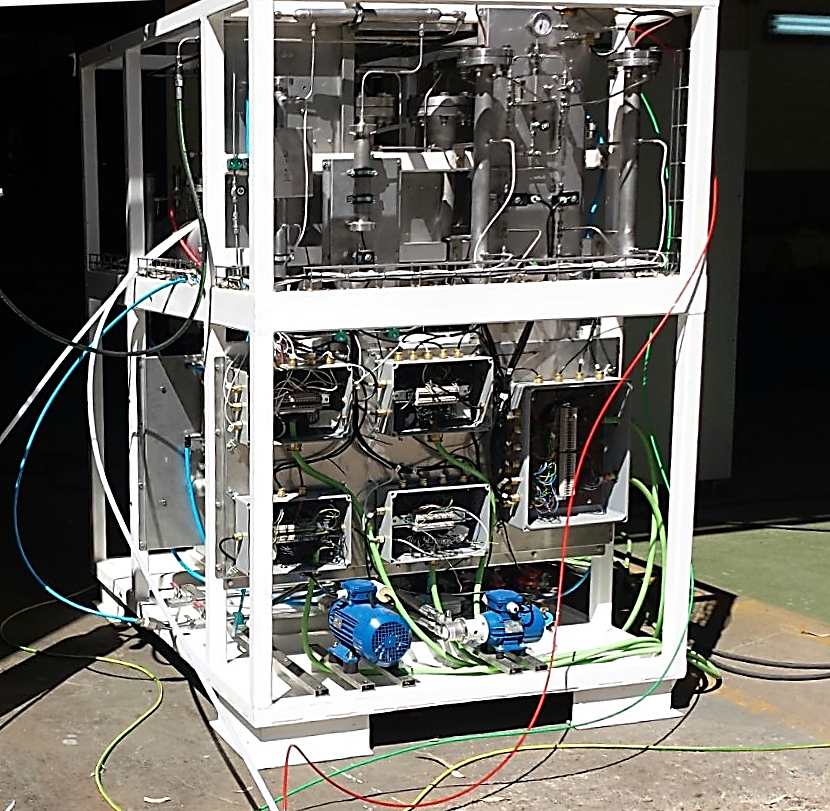 |
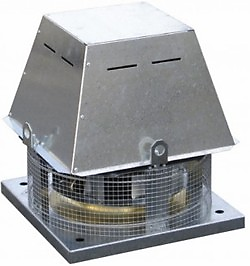 |
| Electrolytic oxygen and hydrogen generator during on-site production tests (left). Roof ATEX extractor fan acquired for the installation (right). |
The pressurized hydrogen tank is also ready to be installed. At present, the moorings and other preparations are being finished for their final placing on the roof. The tank is fully manufactured in steel resisting the hydrogen contact and it has been upgraded, tested and certified to withstand a pressure of more than 20bar, although the expected working pressure would be of 15bar. Its actual 1000 l capacity will allow, therefore, the storage of 15 hydrogen normal cubic metres (Nm3), standing for 1.35 kg of this gas, that is to say, 15 production hours in our prototype at its power rating.
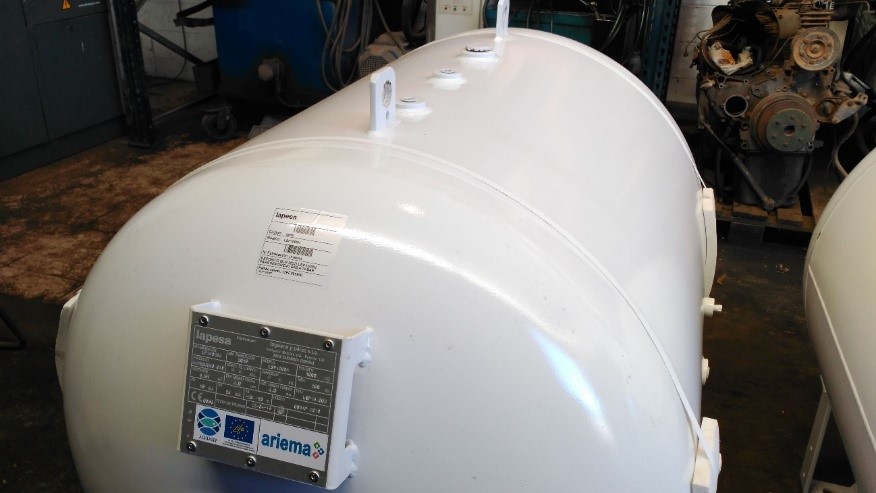 |
|
1 cubic meter and 16bar rating power pressurized hydrogen tank acquired for the project. |
Both hydrogen consuming equipment (the engine-generator and the fuel cell system) have been stored in the production premises for several months waiting for the final wiring once the supply of hydrogen is available. As soon as the on-site oxygen production begins, the associated hydrogen will be used by these devices.
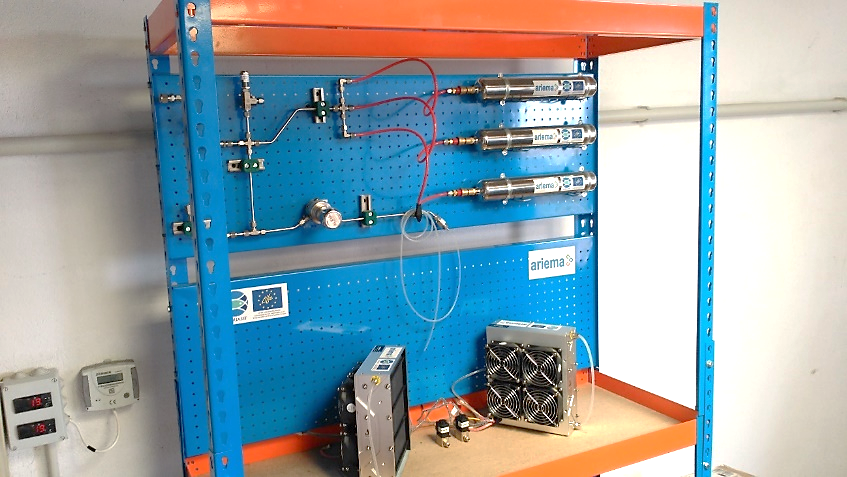 |
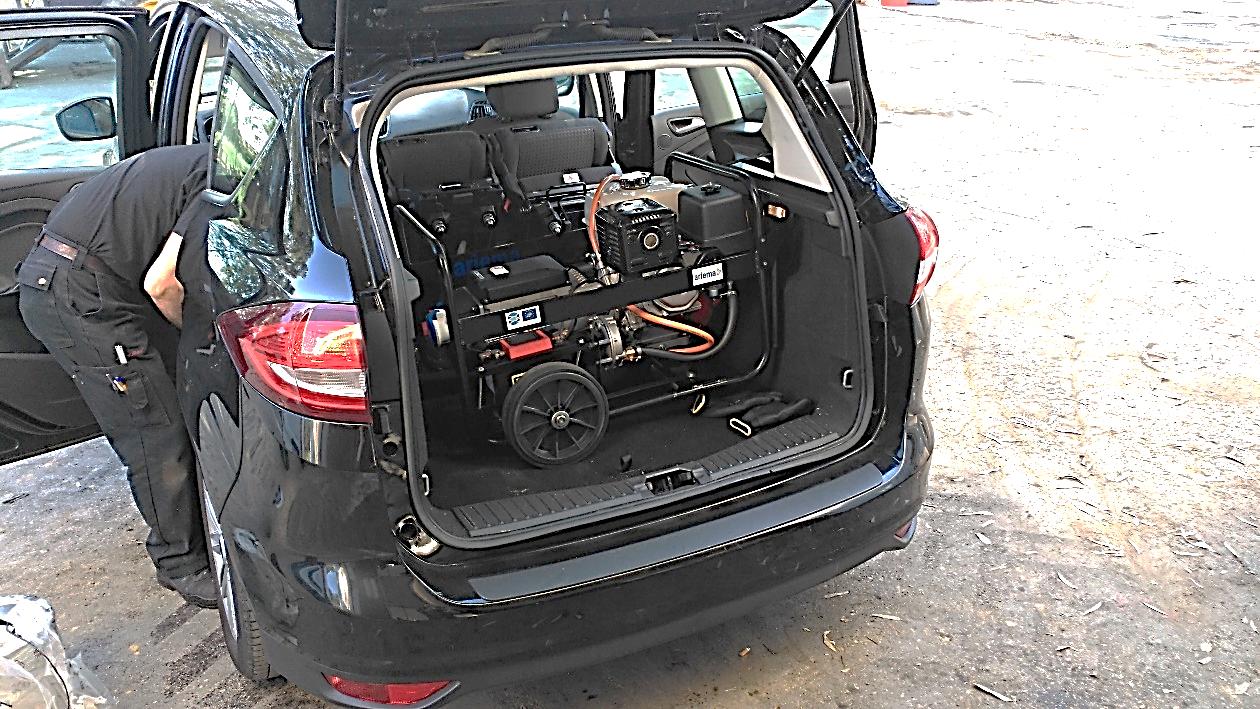 |
| Fuel cell system implemented for the project; the image highlights both the two PEM stacks selected and the three cylinder tanks with metal hydrides (left). Hydrogen-customised engine-generator during transportation to Esteros de Canela (right). |





